المديرون يتعاملون مع الكثير من الأمور.
من ضغط القيادة لتحقيق الأهداف والأهداف إلى توجيه فريقك، يمكن أن يكون تحقيق التوازن بين التوقعات المختلفة عملاً صعباً. وكقائد، فإن إدارة الاجتماعات مطلوبة لمساعدتك في تفويض المهام والحصول على تحديثات الحالة, استراتيجيات العصف الذهني وما إلى ذلك.
يحتاج أي اجتماع، بغض النظر عن نوعه، إلى غرض وهدف وحالة استخدام وجدول أعمال واضح. إن إنشاء جدول أعمال، وتحديد التوقعات، وتتبع المحادثة كلها خطوات مهمة لضمان بقاء الاجتماع على المسار الصحيح ومثمرًا.
لذا، إذا كنت تريد أن تصبح قائد فريق أقوى وتنهي الاجتماعات غير المجدية إلى الأبد، فهذه المدونة لك. لقد أوجزنا لك تسعة أنواع من الاجتماعات التي تحتاج إلى معرفتها وكيفية إدارتها بشكل صحيح.
وكمكافأة إضافية، قمنا بتضمين بعض النماذج المجانية لمساعدتك على تحقيق أقصى استفادة من اجتماعك القادم!
## عناصر الاجتماع التي يجب مراعاتها قبل اختيار نوع اجتماعك
ستساعدك معرفة أنواع الاجتماعات التي يمكن للمدير استضافتها في إعداد فريقك للنجاح. الفعالية إدارة الاجتماعات يمكن أن تساعد في زيادة المشاركة والتعاون عبر الفريق.
فبدلاً من أن يكون نشاطًا متكررًا مستنزفًا، يمكن أن يكون الاجتماع الفعال فرصة فريدة لجمع الأفكار وتقديم المدخلات والتحفيز على النمو المهني ودفع الأهداف التنظيمية إلى الأمام.
قبل اختيار نوع الاجتماع المناسب لفريقك تأكد من مراعاة عناصر الاجتماع هذه:
1. الغرض: ما هو الهدف من الاجتماع؟
2. المشاركون: من يجب أن يحضر ومن سيقود الاجتماع؟
3. جدول الأعمال: ما هي المواضيع التي يجب مناقشتها وبأي ترتيب؟
4. النتيجة: ما الذي تأمل في تحقيقه بنهاية الاجتماع؟
5. التكرار: كم مرة يجب أن يعقد الاجتماع؟
بمجرد أن تأخذ هذه العناصر في الاعتبار، حان الوقت لاختيار أفضل نوع من الاجتماعات لاحتياجات فريقك.
_الآن، دعنا الآن نتعمق في أنواع الاجتماعات التي تحتاج إلى معرفتها وكيفية إدارتها بشكل صحيح باستخدام الأدوات والتقنيات المناسبة!
9 من أكثر أنواع الاجتماعات شيوعًا
فيما يلي تسعة أنواع من الاجتماعات، ونصائح حول إدارة كل منها بنجاح، ونماذج مجانية جاهزة للاستخدام لمساعدتك على البدء!
1. اجتماعات الإعداد
اجتماعات التهيئة هي أول اجتماع بين الموظفين ومديريهم بمجرد انضمامهم إلى المؤسسة. ويمثل هذا النوع من الاجتماعات الاستهلالية بداية تدريبهم وهو أمر ضروري حيث أن فترة تهيئة الموظفين ترسي الأساس لنجاح عضو الفريق الجديد لأنها أول تعمق لهم في عمليات الشركة وأنظمتها.
يجب أن تساعد هذه الاجتماعات المديرين على التعرف على موظفيهم وبناء العلاقات. ومن أفضل الممارسات في هذه الاجتماعات طرح أسئلة لكسر الجليد مثل، ما هي هواياتك، أو ما هو طبقك المفضل، أو أسئلة أخرى تتعلق بالعلاقات الشخصية مثل، كيف تفضل تلقي الملاحظات أو ما الذي يحفزك.
كما يجب أن تحدد اجتماعات التهيئة أيضًا الخطوط العريضة لبرنامج التدريب والموارد ذات الصلة، ومن هم أعضاء فريق العمل، وقائمة مرجعية بـ بنود العمل لإكمالها في أسبوعها الأول. جرب قائمة التحقق من تأهيل الموظفين في ClickUp لدعم موظفيك الجدد ومساعدتهم على الاندماج بسهولة في سير عملهم الجديد.
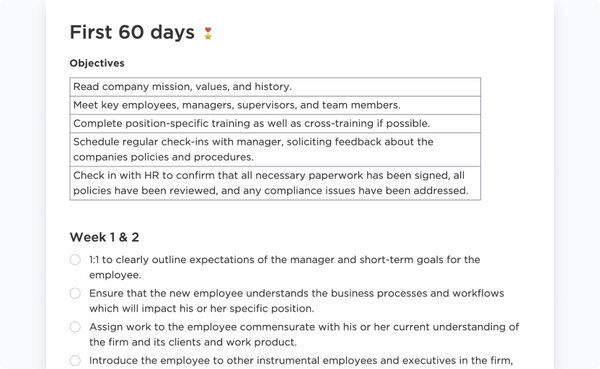
قم بتبسيط عملية تأهيل الموظفين الجدد عملية التهيئة باستخدام هذا النموذج في ClickUp المستندات. يتضمن تفاصيل التعامل مع اليوم الأول والأسبوع الأول وأول 90 يومًا من عملية التأهيل! تنزيل قالب قائمة مراجعة تأهيل الموظفين
2. الاجتماعات الفردية
A اجتماع فردي هو اجتماع بين شخصين، عادةً ما يكون بين المدير وتقريره المباشر. وهي واحدة من أكثر الطرق فعالية للمديرين لبناء العلاقات والثقة مع تقاريرهم المباشرة.
هناك أنواع مختلفة من اجتماعات فردية سيعكس نوع الاجتماع الفردي الذي تستضيفه محتوى جدول الأعمال. على سبيل المثال، فإن أول اجتماع فردي يعقده المدير مع تقرير مباشر سيكون مختلفًا تمامًا عن الاجتماع الفردي الذي يعقده المدير كل أسبوعين.
في Fellow، يعقد المديرون اجتماعات فردية مع تقاريرهم المباشرة للتعرف عليهم بشكل أفضل والاطمئنان على أدائهم. ويطرحون أسئلة لبناء العلاقات أثناء تحديد التوقعات وبنود العمل للمساعدة في إعداد الموظف للنجاح.
يتم توجيه الموضوعات نحو التحقق من تقدم المشروع والعوائق الحالية أثناء إجراء محادثات بناء الحياة المهنية. بغض النظر عن إيقاع الاجتماعات يجب أن يتضمن الاجتماع دائمًا ما يلي
- أسئلة بناء الألفة للاطمئنان على رفاهية بعضنا البعض وحياة كل منا الشخصية
- مناقشة بنود عمل محددة أو أساسية
- بنود عمل واضحة والخطوات التالية عند مغادرة الاجتماع
تكمن أهمية الاجتماع الفردي في قدرته على تعزيز الثقة والترابط الهادف بين الموظف ومديره. ومن العناصر المهمة لضمان فعالية هذا النوع من الاجتماعات أن تطلب من مديرك المباشر أن يتولى إعداد جدول أعمال الاجتماع.
استخدام أداة الاجتماع الفردي لتوثيق المحادثة وإبداء الملاحظات هي أيضًا استراتيجية مفيدة لزيادة فعالية الاجتماع. يمكنك أيضًا الاستفادة من قالب الاجتماع 1:1 الخاص ب ClickUp لتسهيل عقد اجتماع منظم يبني الثقة والألفة.
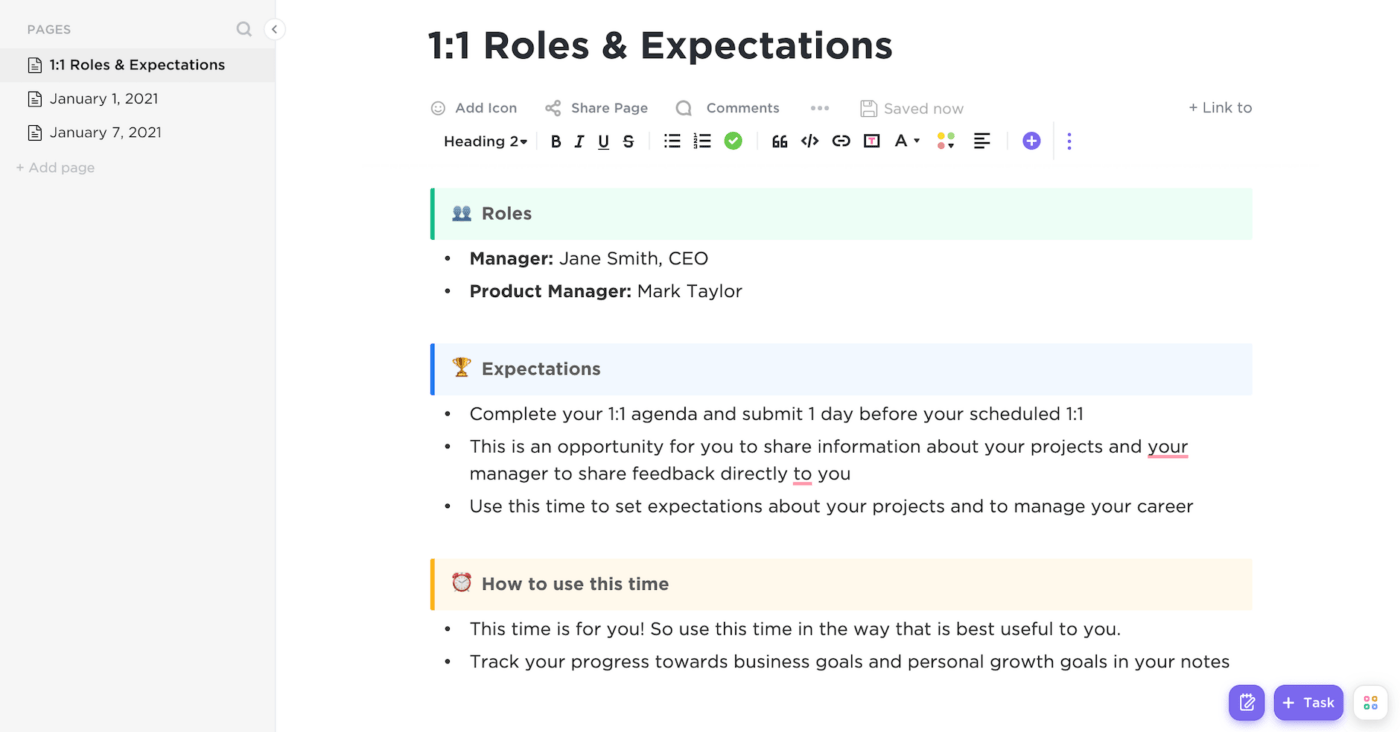
يشتمل قالب ClickUp 1:1 على صفحات معدة مسبقًا لأدوار الموظفين والتوقعات وجداول أعمال الاجتماعات المتكررة لكل عضو من أعضاء الفريق. إنشاء صفحات متداخلة داخل كل صفحة لمزيد من التنظيم تنزيل نموذج الاجتماع 1-1
3. اجتماعات تسجيل الوصول
اجتماعات تسجيل الوصول - يشار إليها أيضًا باجتماعات تحديث الحالة - هي مناقشات تتعاون فيها الفرق وتتبادل التقدم المحرز في موضوع أو مشروع معين. والهدف من ذلك هو ضمان التوافق في الفريق والمشروع مع رفع العوائق التي تحول دون إحراز تقدم.
على الرغم من أن اجتماعات تسجيل الدخول أو اجتماعات تحديث الحالة ليست دائمًا مفضلة للفريق، إلا أنها آلية قيّمة لحل المشاكل والبقاء على اطلاع دائم على تقدم المشروع.
يمكن أن يختلف طول اجتماع تسجيل الوصول بناءً على حالة المشروع وحجمه. فغالباً ما يعقد فريق المبيعات اجتماعات يومية قصيرة للمبيعات للتحقق من تقدم الصفقات والتحديثات التي تتراوح مدتها من 10 إلى 15 دقيقة.
وهناك بديل آخر يتمثل في اجتماعات مراجعة القيادة أثناء الأزمات حيث يشارك كل قسم في تحديثات المشروع. ومن الممكن أيضاً عقد اجتماعات تسجيل حضور أطول للمشروع، حيث تحتاج إلى مناقشة التحديثات ومراجعة بنود العمل السابقة والتقدم المحرز.
يمكن أن تكون اجتماعات تسجيل الوصول ذات طابع غير رسمي أو رسمي، وذلك حسب السياق ومكان عملك. وبشكل عام، يجب أن تعزز اجتماعات تسجيل الوصول الناجحة ما يلي التواصل المفتوح بين كل عضو من أعضاء الفريق وإبقاء الجميع على اطلاع على مجريات الأمور.
يمكن تيسير ذلك من خلال طاولة مستديرة للتحديثات حيث يجب على كل عضو في الفريق إضافة نقاط الحديث المتعلقة بمشاريعهم. كما يتيح لك أيضًا معالجة أي معوقات حتى يتمكن الفريق من التصرف بسرعة ووفقًا لذلك.
لمساعدتك في إدارة اجتماع مثمر، احرص على أن تكون مستعداً بقائمة من أسئلة المراجعة لطرحها على فريقك. يمكنك أيضًا إعدادهم للنجاح من خلال إنشاء حلقة ملاحظات لتسجيل التحديثات والمخاوف والملاحظات المهمة الأخرى.
تتمثل إحدى طرق القيام بذلك في إعداد مستند اجتماع الاستعداد الذي يمكن لفريقك تعبئته قبل الاجتماع! استخدم قالب اجتماع الاستعداد اليومي من ClickUp وقم بتخصيصه ليناسب احتياجات فريقك.
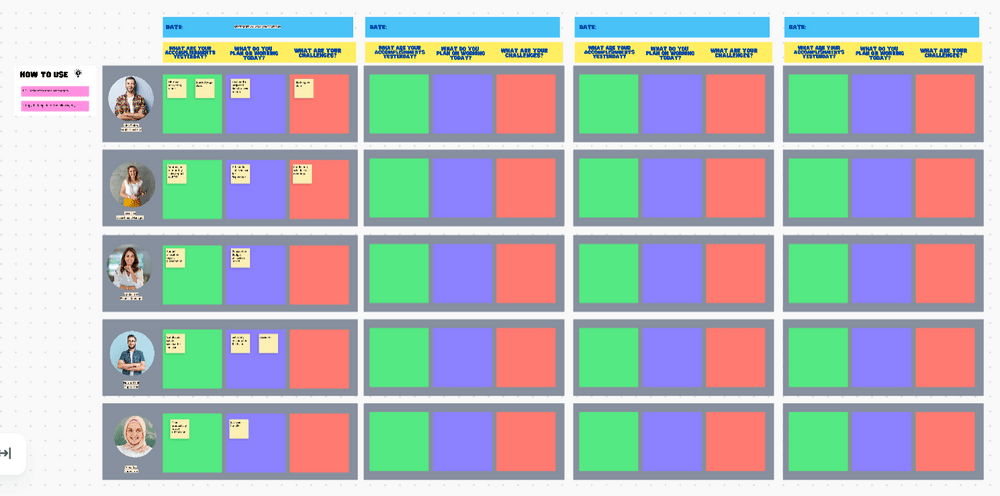
الهدف من اجتماع الاستعداد اليومي هو المساعدة في تنسيق الفريق. تساعد حلقة التغذية الراجعة السريعة هذه الفرق على المواءمة والبقاء على المسار الصحيح، على غرار اجتماع كرة القدم. إذا ظهرت مشكلة ما، يمكنك معالجتها بسرعة وإبقاء المشاريع على المسار الصحيح تنزيل نموذج اجتماع الاستعداد اليومي المكافأة:
/href/ https://clickup.com/blog/conference-agenda-templates// قوالب جدول أعمال المؤتمر* *%/href/_
!
4. اجتماعات العصف الذهني
اجتماع العصف الذهني هو عندما يجتمع فريق لتوليد الأفكار حول موضوع معين. يمكن أن تتم جلسات العصف الذهني بشكل متزامن أو غير متزامن. في سياق غير متزامن فإنك ستحتاج إلى التأكد من أن يكون اتصال الفريق وأدوات التعاون متاحة للمشاركين في الاجتماع.
سيكون العصف الذهني الناجح مثيراً! يجتمع الجميع لإثارة طاقاتهم الإبداعية وتوليد الأفكار. يجب أن تكون السماء هي الحد الأقصى، ولا توجد أفكار سيئة.
يمكن أن تكون الاقتراحات التي يتم توليدها بسيطة جدًا، ولكن يمكن أن تكون معقدة، ومن المهم التأكيد كمنظم للاجتماع على أنه لا توجد أفكار سيئة. من المتوقع أن يشارك جميع الحاضرين في الاجتماع في المحادثة، لذلك يجب أن تتأكد من أن شكل الاجتماع يناسب الحاضرين المنفتحين والانطوائيين.
تعد اجتماعات العصف الذهني جلسات ممتعة وجذابة ولكنها قد تكون مستنزفة ذهنيًا للفريق، خاصة عندما لا يكون هناك نظام لتتبع الأفكار. قد يكون من المفيد جدولة اجتماع متابعة لتضييق نطاق الأفكار المحددة واستخلاصها لاحقًا لزيادة الكفاءة إلى أقصى حد.
جرّب Clickup's ميزة الخريطة الذهنية لالتقاط الأفكار وإضافة التنظيم إلى جلسة العصف الذهني الخاصة بك.
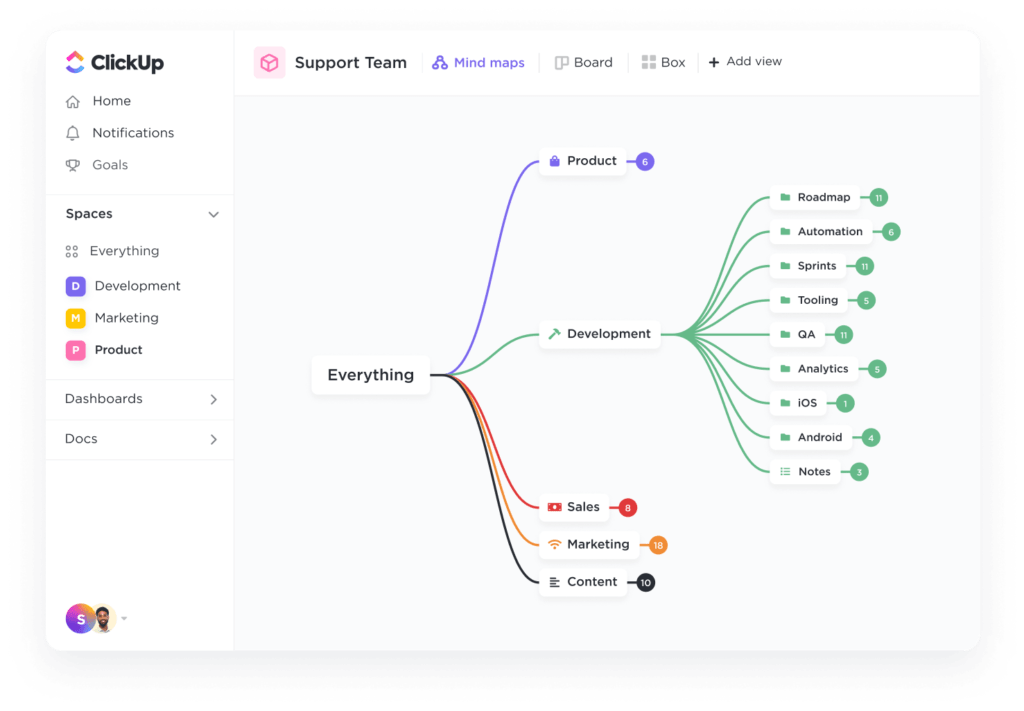
تخطيط وتنظيم جداول أعمال الاجتماعات، أو المشاريع، أو الأفكار، أو المهام الحالية في ClickUp للحصول على مخطط مرئي مثالي
### 5. اجتماعات جميع الموظفين
يعني اجتماع جميع الأيدي أن جميع مستويات المؤسسة ستنضم إلى الاجتماع، بما في ذلك المساهمين الأفراد وقادة الفرق ورؤساء الأقسام والمديرين التنفيذيين. والهدف من ذلك هو مزامنة الشركة بأكملها مع التحديثات ذات الصلة، مثل التحديثات الخاصة بالأقسام أو التغييرات في سياسات الشركة.
كل شركة لديها إيقاع ونقاط حوار مختلفة لاجتماعاتها الجماعية. وعادةً ما يستضيف الرئيس التنفيذي أو رئيس الشركة الاجتماع الفعال لجميع الأيدي بشكل عام وسيتضمن نقاط الحديث تحديثات القيادة أو القسم, مقدمات للموظفين الجدد والمزيد.
على بودكاست سوبرمانجرز ، قال مات مارتن، الرئيس التنفيذي لشركة Clockwise، إن اجتماعهم لجميع العاملين يتضمن العديد من الجوانب المختلفة، بما في ذلك تحديثات الأقسام والعروض التقديمية ونقطة حوار يتم فيها مشاركة لحظات مضحكة من الأسبوع. تستغرق هذه الاجتماعات عادةً ساعة واحدة.
جرب قالب اجتماع كل الأيدي في ClickUp من أجل اجتماع أسبوعي جذاب ومنظم لجميع العاملين.
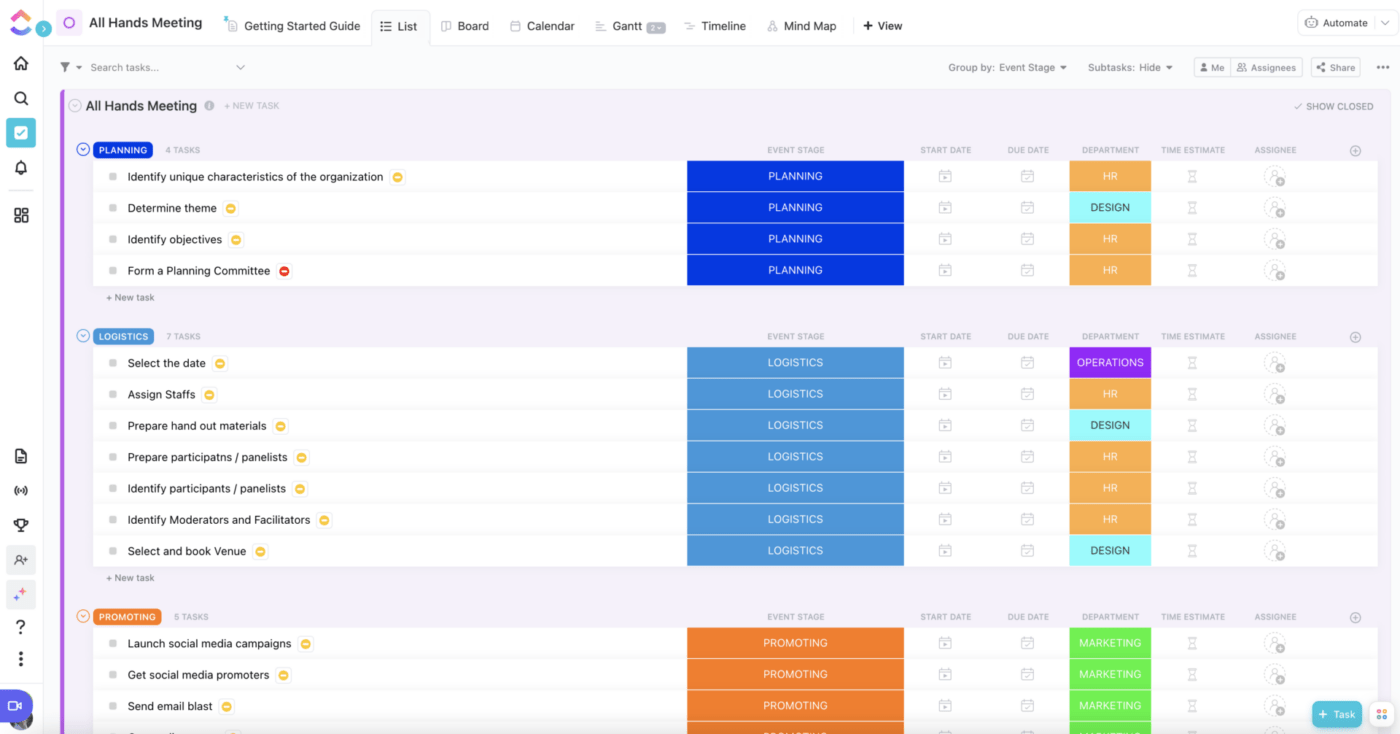
قم بإدارة الخدمات اللوجستية والوقت والتخطيط لاجتماع شركتك التالي بسهولة مع اجتماع كل الأيدي قالب بواسطة ClickUp تنزيل نموذج اجتماع كل الأيدي
6. اجتماعات اتخاذ القرارات
اجتماع اتخاذ القرار هو عندما يجتمع الفريق لإضفاء الطابع الرسمي على قرار ما وتكرار الخطوات التالية. تُستخدم هذه الاجتماعات عمومًا لاتخاذ قرارات مهمة تتطلب التزامًا وربما اتجاهًا جديدًا.
هذه الاجتماعات قياسية في مختلف الفرق: يمكن أن تتضمن اجتماعات مجلس الإدارة أو اجتماعات المشروع اتخاذ القرارات. يجب توثيق القرارات المهمة في أداة محاضر الاجتماعات حتى يتمكن الفريق من تذكر الأساس المنطقي وراء القرار.
تتضمن الأسئلة التي يجب الإجابة عنها خلال هذه الاجتماعات ما يلي:
- نظراً لظروفنا ومواردنا الحالية، ما هو الخيار الأفضل للمضي قدماً؟
- من المسؤول عن الخطوات التالية؟ لماذا؟
على سبيل المثال، يمكن عقد اجتماع لصنع القرار مع مدير التسويق عبر وسائل التواصل الاجتماعي ومنسق التسويق عبر وسائل التواصل الاجتماعي لتغيير اتجاه حملة تسويقية غير ناجحة. إذا احتاج الفريق إلى تقييم ما إذا كانوا يتعاملون مع حملة ما من المنظور والأسلوب المناسبين، فيمكنهم الاجتماع لتقييم المشاركة و نتائج التحويل واختر اتجاهًا جديدًا.
خلال الاجتماع، سيقومون بسرد سبب الحاجة إلى تحويل التركيز وتوثيق السبب الذي يجعل الاتجاه الجديد يبدو مفيدًا. ولذلك، يهدف هذا النوع من الاجتماعات إلى اتخاذ قرار وتوثيقه للمضي قدمًا في مشروع أو مبادرة ما.
راجع هذه
_مراجع/ https://clickup.com/blog/decision-making-templates// قوالب مصفوفة القرار* *%/href/_
!
7. اجتماعات حل المشكلات
تُعقد اجتماعات حل المشكلات بشكل عام بين شخص يواجه تحديًا ما ومدير أو قائد. واعتمادًا على طبيعة المشكلة، يمكن أن يضم هذا الاجتماع ممثلًا عن الإدارات المختلفة، مثل ممثل عن الموارد البشرية أو الفريق القانوني. الهدف من اجتماع حل المشكلات هو إما إيجاد حل للعقبة أو استكشاف إمكانيات الخطوة التالية.
يمكن أن تفيد اجتماعات حل المشاكل أي موظف بغض النظر عن طبيعة المشكلة. خلال هذه الاجتماعات، يجب أولاً تحليل الموقف وأسبابه، وتقييم الاتجاه الذي يجب اتخاذه، ثم وضع خطة عمل لحل المشكلة.
ضع في اعتبارك أن كل خطوة يجب أن تكون موثقة في ملاحظات الاجتماع ومشاركتها مع الأشخاص المشاركين في المحادثة.
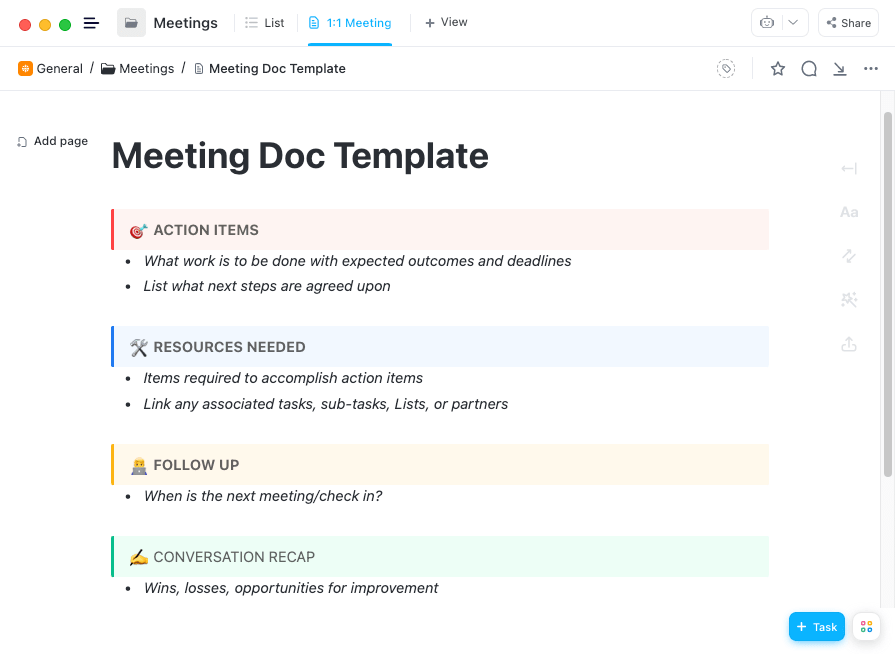
أنشئ قالب الاجتماع الخاص بك وحدد جدول أعمال الاجتماع، وعناصر الإجراءات، وملخصات الاجتماعات، وغير ذلك الكثير في ClickUp Docs تنزيل دليل مستندات ClickUp Docs
8. اجتماعات التخطيط ربع السنوية التخطيط الفصلي هو التنفيذ الاستراتيجي للخطة السنوية المقسمة إلى أربعة أرباع. وفي كل ربع سنة، يتم تحديد هدف منقح للأشهر الثلاثة التالية. يمكن الإبلاغ عن هذه الأهداف المحدثة في اجتماع تخطيط ربع سنوي يتم فيه مناقشة الخطط الاستراتيجية والاحتفال بالإنجازات التي تحققت خلال الـ 90 يومًا الماضية.
هذه الاجتماعات هي فرصة للضغط وإعطاء أو تلقي الملاحظات والمقترحات للأشهر التالية. يجب أن تتضمن كل جلسة تخطيط ربع سنوية أيضًا وقتًا للتفكير في التسعين يومًا الماضية، ومراجعة المهام المنجزة والمهام قيد التنفيذ، والتحضير لما سيأتي في الربع التالي.
الهدف من هذا الاجتماع هو المساعدة في إعداد فريقك للنجاح في تحقيق الأهداف قصيرة المدى وأهداف الشركة على المدى الطويل. 💪
إن مفتاح اجتماع التخطيط الفصلي الفعال هو أن يكون منظمًا. يجب أن تكون نقاط الحديث واضحة وأن يتم تحديد الأهداف التي ستخرج من الاجتماع. بالإضافة إلى ذلك، فإن إعادة عرض الدروس المستفادة من الأرباع الماضية خلال محادثة التخطيط يساعد على النظر في الأهداف المناسبة وذات الصلة.
لا تنسَ تتبع أهدافك في أهداف ClickUp لضمان وجود جداول زمنية واضحة وأهداف قابلة للقياس.
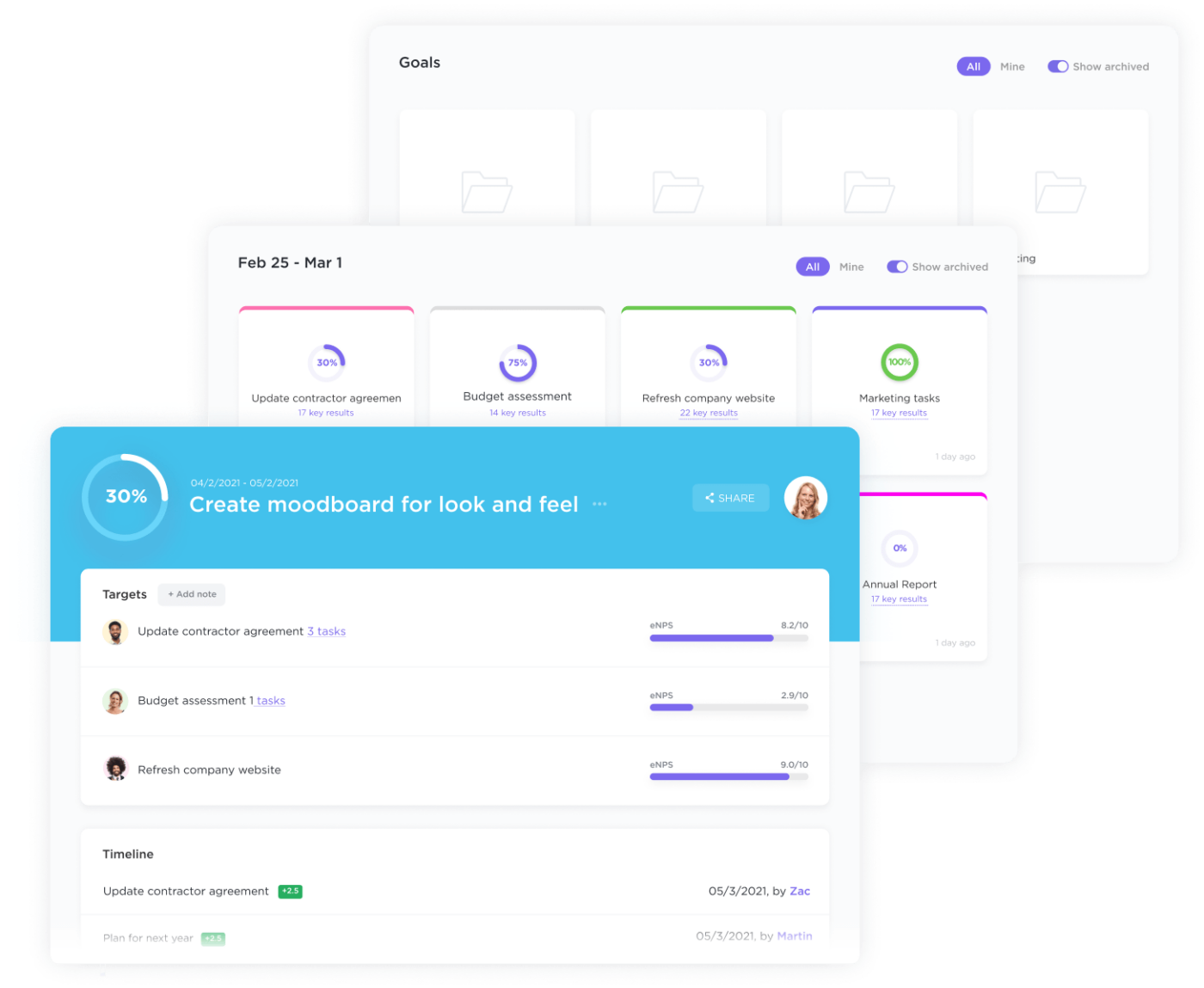
ابقَ على المسار الصحيح لتحقيق أهدافك من خلال جداول زمنية واضحة وأهداف قابلة للقياس وتتبع التقدم التلقائي
9. اجتماعات مجلس الإدارة
اجتماع مجلس الإدارة هو اجتماع رسمي مع مجلس الإدارة بأكمله في منظمة معينة. وتعقد هذه الاجتماعات الرسمية على فترات زمنية مختلفة، مثل ربع سنوية أو سنوية، لمناقشة القضايا المتكررة والهامة، مثل قضايا السياسة أو الأعمال القانونية أو تقارير مؤشرات الأداء الرئيسية أو قضايا متنوعة.
ويترأس الاجتماع رئيس مجلس الإدارة، والمعروف أيضًا باسم رئيس الاجتماع. وبشكل أكثر تحديدًا، فإن الهدف من اجتماع مجلس الإدارة هو وضع السياسة والاستراتيجية، ومراجعة الخطط الاستراتيجية، والتوصل إلى اتفاق بشأن قضية معينة.
وخلال هذا الاجتماع، يتم تسجيل محضر الاجتماع ليشكل وثيقة قانونية يتم نشرها بعد ذلك بما يتوافق مع عمليات مجلس الإدارة. ويُعد نشر محضر الاجتماع أمرًا بالغ الأهمية حيث أنه استراتيجية التواصل بين المنظمة ومجلس الإدارة ومختلف أصحاب المصلحة الخارجيين.

هذه اللوحة جدول أعمال الاجتماع يعمل النموذج كمخطط تفصيلي للتركيز على القضايا الرئيسية ومعالجتها بسرعة والتأكد من أن الجميع على نفس الصفحة بشأن ما يجب القيام به تنزيل نموذج جدول أعمال اجتماع مجلس الإدارة
اجعل اجتماعاتك أكثر إنتاجية باستخدام جدول الأعمال والأدوات المناسبة
هناك العديد من أنواع الاجتماعات المختلفة ذات الأغراض المختلفة. وقد يكون التنقل بين الاجتماعات التي يجب استخدامها في أي ظرف من الظروف تحدياً للمدراء.
من خلال تنفيذ استراتيجيات فعالة لإدارة الاجتماعات والاستفادة من الأدوات الصحيحة
أدوات الاجتماعات عبر الإنترنت
مثل
انقر فوق
لمساعدتك على إدارة عملك وجداولك الزمنية وفريقك وغير ذلك، يمكنك تجنب الاجتماعات غير المنتجة والبدء في إدارة جلسات تعاونية تنشط و
تحفيز فريقك
لتحقيق أهدافهم.
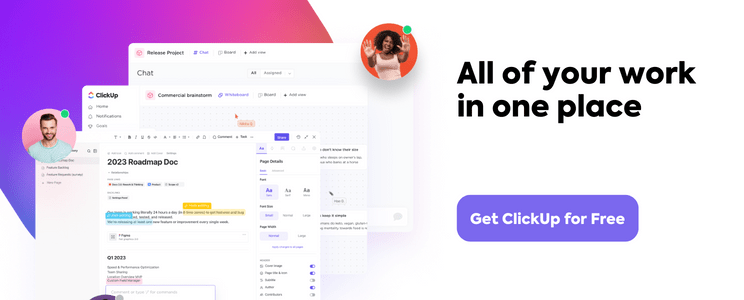 الكاتب الضيف:_
الكاتب الضيف:_

/href/ http://fellow.app Fellow.app /%%href/
_ هو برنامج إدارة الاجتماعات الأعلى تصنيفًا الذي يساعد المديرين وفرقهم على بناء عادات فعالة للاجتماعات من خلال جداول الأعمال التعاونية وتتبع بنود العمل ومكتبة من قوالب الاجتماعات المعتمدة من الخبراء
